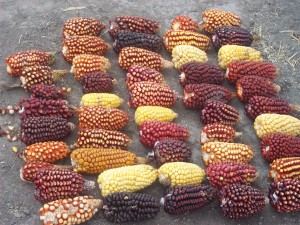
Red root marker creates new opportunities for DH breeding

Doubled haploid (DH) technology provides important benefits to maize breeding programs, as DH lines enhance genetic gains and improve breeding efficiency in addition to offering significant economic advantages. DH lines can be generated in less than half as many seasons as lines generated through traditional breeding, thus saving valuable time, resources and energy. The large scale production of DH lines is dependent on the identification of haploids at an early seedling stage. Haploids have traditionally been identified by the R1-nj (Navajo) anthocyanin color marker which, when crossed with haploid inducer lines through induction crosses, will produce haploid progeny seed with purple markings on its outer layer, or pericarp. This is to differentiate haploid from diploid seedlings, which are not useful for DH breeding.
Unfortunately, DH production is limited by the fact that the R1-nj marker cannot effectively identify haploids in many crosses where inhibitor genes prevent color expression in the seed. A new study by MAIZE CRP Director B.M. Prasanna in collaboration with Vijay Chaikam, Leocadio Martinez, Albrecht E. Melchinger and Wolfgang Schipprack with funding from the MAIZE CRP found that the Navajo marker caused a high percentage of false positives, especially in varieties with natural purple coloring due to high anthocyanin content. To combat this issue, the study suggests the use of triple anthocyanin color markers, in which in the red/purple coloration is expressed in the seedling roots and leaf sheaths in addition to the Navajo marker on the seed. This red root marker allows haploids to be distinguished from diploids at an early seedling stage, saving time and money in DH breeding programs.
The study found that the use of the red root marker improved the accurate identification of haploids, especially in seeds that already have a natural purple color due to high anthocyanin content. While most breeding programs focus on yellow and white varieties, 40% of the landraces tested in this study had natural anthocyanin accumulation, some of which have significant nutritional and economic value. Red root marker is useful in these cases as Navajo color markers cannot be used to test these varieties due to the similarities in coloring. As it is very rare that seedling roots would naturally be red due to anthocyanin accumulation in comparison to seeds and leaf sheaths, the study suggests that red root marker be used in addition to the R1-nj seed marker in order to avoid false positives and improve the identification of haploids “within a wide range of tropical maize germplasm.”
To read the full study, please click here:
Vijay Chaikam; Leocadio Martinez; Albrecht Melchinger; Wolfgang Schipprack; B. Prasanna
doi: 10.2135/cropsci2015.10.0653; Date posted: January 04, 2016
